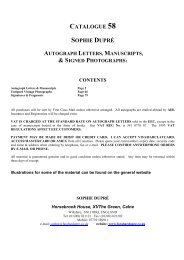CLIVE FARAHAR Catalogue 60
CLIVE FARAHAR Catalogue 60
CLIVE FARAHAR Catalogue 60
You also want an ePaper? Increase the reach of your titles
YUMPU automatically turns print PDFs into web optimized ePapers that Google loves.
RARE CHINESE SURVIVAL<br />
1. Magnificent Collection of 65 Trays of Handcarved, Wooden Chinese Movable Type, c.1800<br />
most about 17 x 10 ins, of wooden type in three sizes , containing in excess of 50,000 pieces<br />
carved to a very high standard of elegance, in the style known as Old Song [Sung], the small<br />
types having a gem-like quality of engraving, and the large a fine boldness, [116<strong>60</strong>] £35,000<br />
Although all the type has been inked, at least for proofing, many of the pieces show little wear, others<br />
show regular use, but the general condition is very fine.<br />
Previous to the 18th century, Chinese characters in dictionaries or fonts were sorted by tone and rhyme.<br />
The reduction to the classic 214 radicals appears in the great Kangxi dictionary (c. 1723), and is used<br />
for example in the index to Mathews’ Chinese-English Dictionary of approximately 8000 characters.<br />
Printing with movable type in China - in ceramic, bronze, wood or in modern times lead - has a long<br />
but sporadic history. Owing to the vast initial investment it has generally been used only for very large<br />
Imperial works (such as encyclopaedias), for high volume coupled with speed (such as with<br />
newspapers), and by itinerant updaters of clan histories (probably using limited fonts). The forerunner<br />
of the Peking Gazette was set in wooden type from 1628. Up to at least the begining of the 20th century,<br />
the scholarly tradition of a preserved text and many practical considerations, not least the labour in<br />
picking and distributing type, favoured woodblocks for smaller works.<br />
The grain and weight of the present types suggest a fruit wood, perhaps pear or jujube, rather than<br />
boxwood.<br />
We believe the present trays to be of the greatest rarity, and unparalleled in the U.K. For them to have<br />
survived through the turbulent history of 19th and 20th century China, with its various “Cultural<br />
Revolutions”, is a phenomenon. They present in physical form a thesaurus of the Chinese literary<br />
language, as well as the artistic study of the characters themselves.<br />
References:<br />
Wan-go H.C. Weng, ‘Chinese Type Design and Calligraphy’, pp. 26-30 in ‘Chinese Rare Books in<br />
American Collections’, ed. Sören Edgren, Exhibition <strong>Catalogue</strong>, 20th October 1984 - 27th January<br />
1985, China Institute in America, New York, 1985. For the 1726 encyclopaedia in bronze types (melted<br />
down 1744), see item 39, pp.122-123. For the 1773 encyclopaedia in wooden types, see item 40, pp.<br />
124-125.<br />
Tsien Tsuen-Hsuin, Ph.D., Prof. Emeritus, University of Chicago, ‘Paper and Printing’, Vol. V Part I of<br />
‘Science and Civilisation in China’, ed. Joseph Needham, C.U.P. 1987, ISBN 0-521-08690-6. With<br />
illustrations of typesetters at work. See especially p. 201ff.<br />
J. Mathews, Chinese-English Dictionary, Shanghai 1931, (second Harvard edition reprinted 1996).<br />
Shiow-jyu Lu Shaw, ‘The Imperial Printing of Early China, 1644-1805’, San Francisco, Chinese<br />
Materials Centre, 1983, ISBN 0-89644-621-2. (Asian Library Series, no. 20). Has many details of<br />
costs and wages for type production.<br />
2. ABORIGINES. Tracts Relative to The Aborigines. Published by Direction of the Meeting for<br />
Sufferings from 1838 to 1842, [a collection of 8 Tracts with general title and contents leaf] 1.<br />
Information Respecting The Aborigines in the British Colonies Circulated by Direction of the<br />
Meeting for Sufferings. Being Principally Extracts from the Report Presented to the House of<br />
Commons, by the Select Committee appointed on that subject xii + <strong>60</strong> pp. 1838, Sabin 34705.<br />
2 Wheeler (Daniel) Effects of the Introduction of Ardent Spirits and Implements of War,<br />
Amongst the Natives of some of the South-Sea Islands and New South Wales, Second Edition,<br />
22 pp. 1843, Sabin 103180, Ferguson 3770. 3. Further Information Respecting the Aborigines,<br />
containing Extracts from the Proceedings of the Meeting for Suffering in London, and of the<br />
Committees on Indian Affairs, of the Yearly Meetings of Philadelphia and Baltimore, together<br />
with some particulars relative to the Seminole War, Second Edition, 34 pp. 1843, Sabin 34651.<br />
4. Facts Relative to the Canadian Indian, published by the direction of the Aborigines’<br />
Committee, of the Meeting for Sufferings, ii + 24 pp. 1839, Sabin 23634. 5. The Report of the<br />
Aborigines’ Committee of the Meeting for Sufferings, read at the yearly meeting 1840: with the<br />
Address to Lord John Russell, on His becoming Secretary for the Colonies; that to Friends<br />
Settling in New Colonies; and some Particulars calculated to give information, and promote<br />
interest respecting the Present State of Aboriginal Tribes, 20 pp. 1840, Sabin 34667, 6. An





